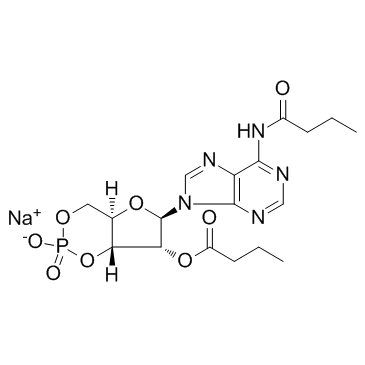Bucladesine (sodium salt)

Bucladesine (sodium salt) structure
|
Common Name | Bucladesine (sodium salt) | ||
|---|---|---|---|---|
| CAS Number | 16980-89-5 | Molecular Weight | 491.367 | |
| Density | N/A | Boiling Point | N/A | |
| Molecular Formula | C18H23N5NaO8P | Melting Point | N/A | |
| MSDS | Chinese USA | Flash Point | N/A | |
|
H4 histamine receptors inhibit steroidogenesis and proliferation in Leydig cells.
J. Endocrinol. 223(3) , 241-53, (2014) The histamine H4 receptor (HRH4), discovered only 13 years ago, is considered a promising drug target for allergy, inflammation, autoimmune disorders and cancer, as reflected by a steadily growing number of scientific publications and patent applications. Alt... |
|
|
Critical period for dopaminergic neuroprotection by hormonal replacement in menopausal rats.
Neurobiol. Aging 36(2) , 1194-208, (2015) The neuroprotective effects of menopausal hormonal therapy in Parkinson's disease have not yet been clarified, and it is not known whether there is a critical period. Estrogen induced significant protection against 6-hydroxydopamine-induced dopaminergic degen... |
|
|
Extracellular ATP induces intracellular alpha-synuclein accumulation via P2X1 receptor-mediated lysosomal dysfunction.
Neurobiol. Aging 36(2) , 1209-20, (2015) The pathologic hallmark of Parkinson's disease (PD) is the accumulation of alpha-synuclein (αsyn) in susceptible neurons in the form of Lewy bodies and Lewy neurites. The etiology of PD remains unclear. Because brain injury has been suggested to facilitate αs... |
|
|
Interaction between nonviral reprogrammed fibroblast stem cells and trophic factors for brain repair.
Mol. Neurobiol. 50(2) , 673-84, (2014) There are currently no known treatment options that actually halt or permanently reverse the pathology evident in any neurodegenerative condition. Arguably, one of the most promising avenues for creating viable neuronal treatments could involve the combined u... |
|
|
The secretogranin II gene is a signal integrator of glutamate and dopamine inputs.
J. Neurochem. 128(2) , 233-45, (2014) Cooperative gene regulation by different neurotransmitters likely underlies the long-term forms of associative learning and memory, but this mechanism largely remains to be elucidated. Following cDNA microarray analysis for genes regulated by Ca(2+) or cAMP, ... |
|
|
Renin knockout rat: control of adrenal aldosterone and corticosterone synthesis in vitro and adrenal gene expression.
Am. J. Physiol. Regul. Integr. Comp. Physiol. 308(1) , R73-7, (2015) The classic renin-angiotensin system is partly responsible for controlling aldosterone secretion from the adrenal cortex via the peptide angiotensin II (ANG II). In addition, there is a local adrenocortical renin-angiotensin system that may be involved in the... |
|
|
Action of db-cAMP on the bystander effect and chemosensitivity through connexin 43 and Bcl-2-mediated pathways in medulloblastoma cells.
Oncol. Rep. 28(3) , 969-76, (2012) Medulloblastoma (MB) is one of the most common malignant brain tumors of childhood and is associated with a poor prognosis. Gap-junctional intercellular communication (GJIC) is an important mode for cell-to-cell communication. Dysfunctional GJIC is exhibited ... |
|
|
Mechanisms of action of hormone-sensitive lipase in mouse Leydig cells: its role in the regulation of the steroidogenic acute regulatory protein.
J. Biol. Chem. 288(12) , 8505-18, (2013) Hormone-sensitive lipase (HSL) catalyzes the hydrolysis of cholesteryl esters in steroidogenic tissues and, thus, facilitates cholesterol availability for steroidogenesis. The steroidogenic acute regulatory protein (StAR) controls the rate-limiting step in st... |
|
|
Inhibition of the microglial response is essential for the neuroprotective effects of Rho-kinase inhibitors on MPTP-induced dopaminergic cell death.
Neuropharmacology 85 , 1-8, (2014) Several recent studies have shown that activation of the RhoA/Rho-associated kinase (ROCK) pathway is involved in the MPTP-induced dopaminergic cell degeneration and possibly in Parkinson's disease. ROCK inhibitors have been suggested as candidate neuroprotec... |
|
|
cAMP-mediated stabilization of fusion pores in cultured rat pituitary lactotrophs.
J. Neurosci. 33(18) , 8068-78, (2013) Regulated exocytosis mediates the release of hormones and transmitters. The last step of this process is represented by the merger between the vesicle and the plasma membranes, and the formation of a fusion pore. Once formed, the initially stable and narrow f... |